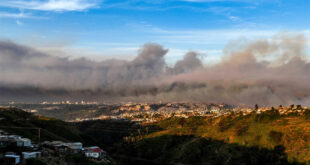The Covid pandemic and the Ukraine war have slowed the delivery of rare construction materials from Europe, says the priest in charge of restoring downtown Saigon’s bright red Notre Dame Cathedral.
Work began on the VND140 billion (US$5.98 million) project to renovate the 147-year-old Notre Dame Cathedral Basilica in 2017. The project was originally expected to be finished this year, but the completion date has since been pushed back until 2027.
Priest Ignatio Ho Van Xuan, head of the church’s renovation board, spoke with VnExpress in an exclusive interview about the unexpected challenges and difficulties that have caused the renovation work to drag on much longer than planned.
After six years, how is the project going?
Currently, the restoration work is 50% complete. It has been carried out on the principle of keeping intact the parts that are still good enough and replacing the parts that are too damaged. To date, no items have been completed. For example, the roof has been beautifully restored, but the gutter system for it has not been completed because the restoration of two bell towers and the metal towers with two crosses must be completed [before installing the gutters]. The items are all linked to each other, so they need to be completed synchronously.
Most recently, the two crosses at the cathedral have been taken down and will be sent to Belgium for restoration.
The Monument Group [the Belgium-based firm helping restore the church] said it would complete the project in late 2027.
 |
|
Priest Ignatio Ho Van Xuan, head of the Notre Dame Cathedral Basilica’s renovation board. Photo by VnExpress/Quynh Tran |
At first, the Archdiocese of Ho Chi Minh City expected the project to last two or three years, but now it is scheduled to take a decade. Why is it taking so long?
The Archdiocese raised the issue of preserving the cathedral in 2015. After two years of preparation, work began on July 1, 2017, when much of the church was seriously dilapidated. When installing the scaffolding to approach the bell towers, the zinc towers and the two crosses – at an altitude of more than 60 meters – we found that all those items had been badly damaged because of more than a hundred years of exposure to heat and rains.
According to European standards, an old church must be restored every 50 years, and must be completely renovated every 100 years. However, foreign experts said that although we are late in trying to preserve the church after 137 years, there is still enough time to restore it.
When I first traveled to Belgium to sign the agreement with the Monument Group, I met the bishop of the Diocese of Tournai, who was repairing the 800-year-old Notre Dame Basilica of Tournai. When I expressed my desire to have the restoration completed in about two years, the bishop said it is impossible for a church of more than 100 years old to be preserved in that short a time. He cited the Tournai church itself, for which restoration work has been going on for more than 20 years and has not yet been completed.
So, when I sat down with the Monument Group’s experts, we agreed that the project should not be rushed, but instead carried out very carefully to ensure the longevity of the church. This was also the desire of Archbishop Paul Bui Van Doc when he was still alive: he wished that the preservation would ensure that the Saigon Notre Dame Cathedral would keep its original architecture and stand firm for hundreds of more years for the next generations.
There were also a number of unexpected issues that caused the renovation work to last longer than needed. The Covid-19 pandemic disrupted the supply of materials from Europe for two years, and then the war in Ukraine affected the supply chain globally, pushing up the prices of raw materials and also making them more scarce.
Which part of the church that is most difficult to be restored?
That would be the bell towers and the towers above them. Fifteen years after the [cathedral structure’s] completion in 1895, two towers on top of the two bells towers were added. This makes the church unique.
On the four corners of the two bell towers, there are hundreds of Pierre de Paris limestone blocks, which are beautifully sculpted, but have been eroded and damaged by rainwater. Each stone weighs about four tons, so it is not easy at all to bring them down. We had to chop the stone into pieces of 500 kilograms each and bring them down by an elevator.
After consulting with experts, we decided to use Pierre de Massengis as an alternative. This stone is harder and more beautiful, but it must be ordered in France and then transferred to the factory in Belgium for processing according to the designs of Monument Group. The total weight of the stone blocks imported to the church to be installed in the towers is nearly 90 tons.
It costs about 170,000 euros ($185.2 million) to process those blocks, but the corporation donated that money to the church. Currently, some blocks have been added to the tower already.
Another difficulty is that the metal sheets on the towers above the bell towers have been oxidized and corroded, and some of them have even fallen into the street but fortunately did not hurt anyone. To replace those sheets, I had to go to a factory in France in 2016 to order Azengar zinc to re-roof the two towers.
 |
|
Part of the construction site to renovate the Saigon Notre Dame Cathedral, March 2023. Photo by VnExpress/Quynh Tran |
Why do we have to use materials imported from abroad, instead of those produced in Vietnam, which could save costs?
Saigon Notre Dame Cathedral was designed with a blend of Roman and Gothic architectural styles. This is unique compared the Notre Dame Cathedral in Paris, which was done only in the Gothic style. All materials to build the Saigon church were brought from France. Therefore, the materials used for restoration must be similar to the old materials so as not to change the appearance of the building.
At the time of preparation, I did a little research and found no company in Vietnam that restores churches built by European people. Therefore, we had to approach companies with more than 100 years of experience in Europe to get the right materials. For example, we have cement imported from Belgium, as well as sand, tiles, and mortar from France and Germany.
Some of the materials that are bulky and large are transported by sea from the ports of Hamburg (Germany), Rotterdam (Netherlands), Antwerp (Belgium). Such a voyage takes six weeks on average. Meanwhile, materials and equipment that need to be used urgently to keep up with the schedule must be transported by plane at a very high cost.
Monument Group restored the Rouen Cathedral in France, and the Tournai Cathedral and Saint Jacques Cathedral in Belgium, as well as the Notre Dame de Paris.
Every day we have to take pictures of the work to report to the corporation’s experts. Each of the project’s workers must undergo training and recruitment exam.
Many people usually wonder why when looking from the outside, it appears there is only scaffolding and no one is working. But in fact, workers are working inside the building in the bell tower area. And there are days when the engineers and workers work more than eight hours a shift.
 |
|
The Saigon Notre Dame Cathedral, an icon of Ho Chi Minh City, in 2017. Photo by VnExpress/Quynh Tran |
The cost of restoring the church was originally estimated at VND140 billion. Where does the funding come from?
When tasked with the responsibility of restoring the church, I was very worried because I did not know where to get the money for such expensive work. To date, all funds have been contributed by parishioners right here the city, and those living abroad. I have seen many people struggling with their own difficulties still willing to help the church.
At first, the cost of restoration was estimated at VND140 billion, but so far it has not been possible to calculate the exact figure because the costs of materials and transportation have changed over time.
The church is still operating during the renovation. What measures does the restoration board take to ensure the safety of parishioners going to mass without disrupting the conservation process?
At first, many people suggested that the church should be closed until the restoration was completed. When I presented this idea to my superiors, that proposal was rejected because some parishioners in the city have developed the habit of attending mass at the cathedral. On weekends, the church still receives 6,000-7,000 people so if the place is closed, where would they go? Closing the church would be like disbanding the community here and it would not be easy to gather them back once the work is done.
And during overall inspections, the construction unit concluded that the foundation and structure of the church are still very good, so the church could continue to hold masses as usual.
After the restoration, what will the church look like and how will its architecture be preserved?
The architecture of the church will remain the same but its appearance will be more beautiful as all the parts that are damaged or vandalized with graffiti will be replaced or cleaned. I estimate the process to beautify the church will take a lot of time and cost a lot of money because there are hundreds of thousands of bricks that need to be replaced. Five years ago, I went to Germany to order similar bricks from Girnghuber for the process.
To avoid vandalism, we will recommend the city build fences around the church. We are proposing the area in front of the church be a pedestrian only street connected to the flower garden to prevent vehicles from entering and ensure the safety of worshipers and visitors.
Inside the church, we will rebuild the ventilation system, so that parishioners will be more comfortable attending mass on hot days. Inside the Holy Palace, we plan to install a pipe organ like many churches in Europe. In addition, we would like to install an external lighting system to make the church glow at night.
After the restoration, the church is expected to stand for at least another 100 years. Whether it could last longer depend on many factors. We will have a maintenance team, like many churches in Europe, to repair the church whenever it is needed.
Notre Dame Cathedral is not only a symbol of the church, but one of the city’s religious, artistic, and architectural monuments that needs to be preserved. People and tourists from many provinces and cities, when coming to Ho Chi Minh City, want to visit and admire the church.
- Reduce Hair Loss with PURA D’OR Gold Label Shampoo
- Castor Oil Has Made a “Huge” Difference With Hair and Brow Growth
- Excessive hair loss in men: Signs of illness that cannot be subjective
- Dịch Vụ SEO Website ở Los Angeles, CA: đưa trang web doanh nghiệp bạn lên top Google
- Nails Salon Sierra Madre
 VnExpress News The News Gateway of Vietnam
VnExpress News The News Gateway of Vietnam




